In early April 1982, Argentina invaded the Falkland Islands, a few desolate rocks in the South Atlantic. The British mobilized their fleet in response. After a fierce battle in the air and at sea, the British gained the upper hand, and began landing troops on May 21st at San Carlos Water on the west coast of East Falkland. The Argentinians attempted to defeat the invasion with air attacks, but the British eventually gained the upper hand. On the 28th, the British, despite some setbacks, began the ground campaign, defeating the Argentinian garrison at Goose Green and opening the way to lay siege to the main enemy positions near Stanley. The first days of June saw the islands shrouded in clouds, but that didn't prevent the British from leapfrogging forward to Fitzroy and Bluff Cove, just to the south of Stanley. There, tragedy struck on June 8th, when an air attack caught several ships unloading.1
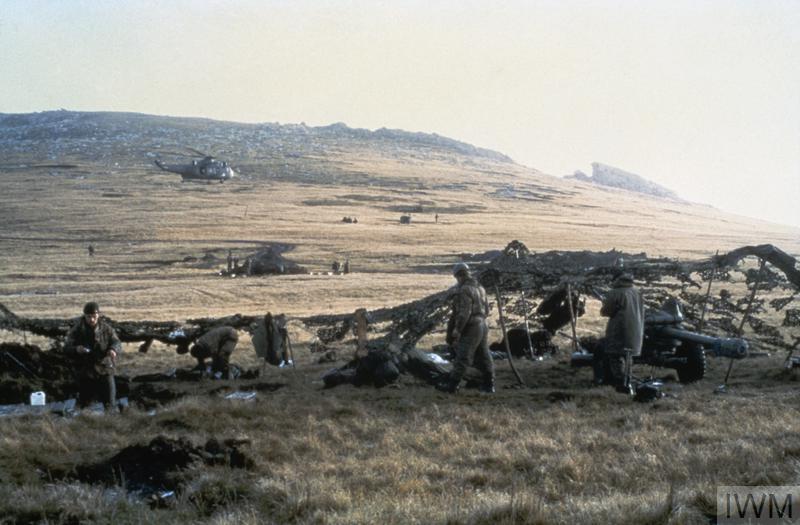
An artillery battery in the Falklands
Despite the losses at Bluff Cove, the British continued their buildup for the assault on Stanley. All of the helicopters and crews had finally arrived, giving a total of 40 during the day and 4 at night, most employed bringing up artillery ammunition to the British forward batteries. The 9th was quiet, with only a couple of air raid warnings and no actual attacks. Survivors from Bluff Cove were evacuated to the hospital ship Uganda, while there was the usual shuffle of ships between San Carlos, the carrier group, and the logistics area.
The 10th opened with Yarmouth conducting a very successful midnight bombardment of Argentine positions, setting off secondary explosions along the line. The British used the day to continue the buildup, although perhaps the most important supply efforts took place within San Carlos, where the supply ship Fort Grange was transferring food to the amphibious force. The situation was so bad that LSL Sir Percivale had only two days worth of balanced rations for her crew remaining. The Argentinians were more active than they had been the previous day, starting with an ineffective attack by a quartet of Pucaras on the British artillery positions near Mount Kent. Aircraft from the mainland began to show up on Exeter's radar screens in the afternoon, and extra Sea Harriers were quickly scrambled from the strip ashore and from the carriers. Within an hour, 16 British fighters had appeared over the islands, and the Argentinians chose to withdraw without a fight under the able guidance of VYCA-2.
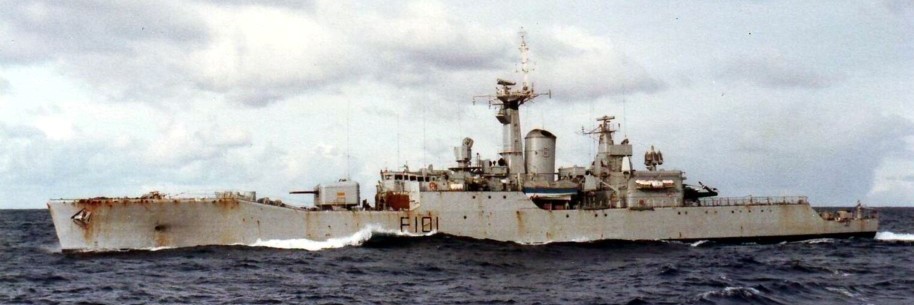
Yarmouth showing the strains of war
While the nightly naval bombardment of the Argentine defenses was often quite effective, it was limited by the threat of Exocets that had been dismounted from various surface ships and flown into the Falklands. These covered the areas to the south of Stanley fairly well, so the British decided to sweep new areas to the north, using converted fishing trawlers. The acoustic sweep on one of the trawlers, Pict, failed, and the commander decided to solve the problem by getting his crew on deck and turning on all of the auxiliary machinery to make the ship as noisy as possible. Fortunately, there were no mines in the area.
To prevent any repeat of the dawn Pucara attack, the British hit Stanley airport at first light on the 11th with a group of Sea Harriers lofting bombs in, the last raid on the airfield. A total of 123 sorties had been directed against it from the carriers (not including Black Buck). They followed this with a precision strike on the Town Hall, which had been taken over by the occupiers as a headquarters. A Wessex armed with AS.12 missiles flew in at low level and launched a single missile, which missed. A second missile was dispatched despite heavy AA fire, and came close to its target, instead hitting the police station and causing significant alarm among the military intelligence unit billeted there. At dusk, the Pucaras attempted another assault on the British batteries, guided in by smoke shells from the Argentinian artillery. Unfortunately, this raid, the last mission of the Pucaras, turned out to be ineffective.
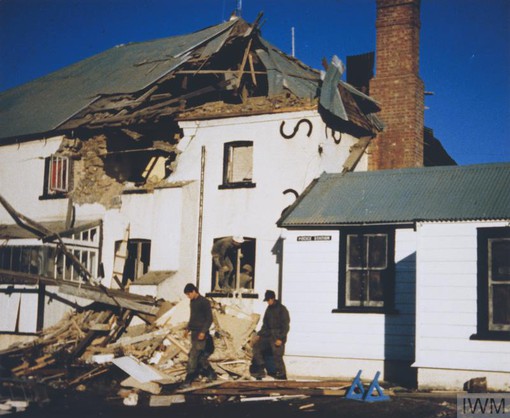
The results of the missile strike on the Police Station
The evening of the 11th had been chosen as the time for the long-awaited assault on Stanley to finally kick off, and the British made extensive preparations to support it during the day, with Harrier GR3s attacking various positions with cluster bombs. One had a narrow escape as a small-caliber bullet went through the cockpit. Glamorgan, who had been manager of the logistics area far offshore since the start of the month, was rotated in to replaced Plymouth, and led Avenger and Yarmouth in to the gunline to support the attack from the south, while Arrow used the newly-swept area to the north.
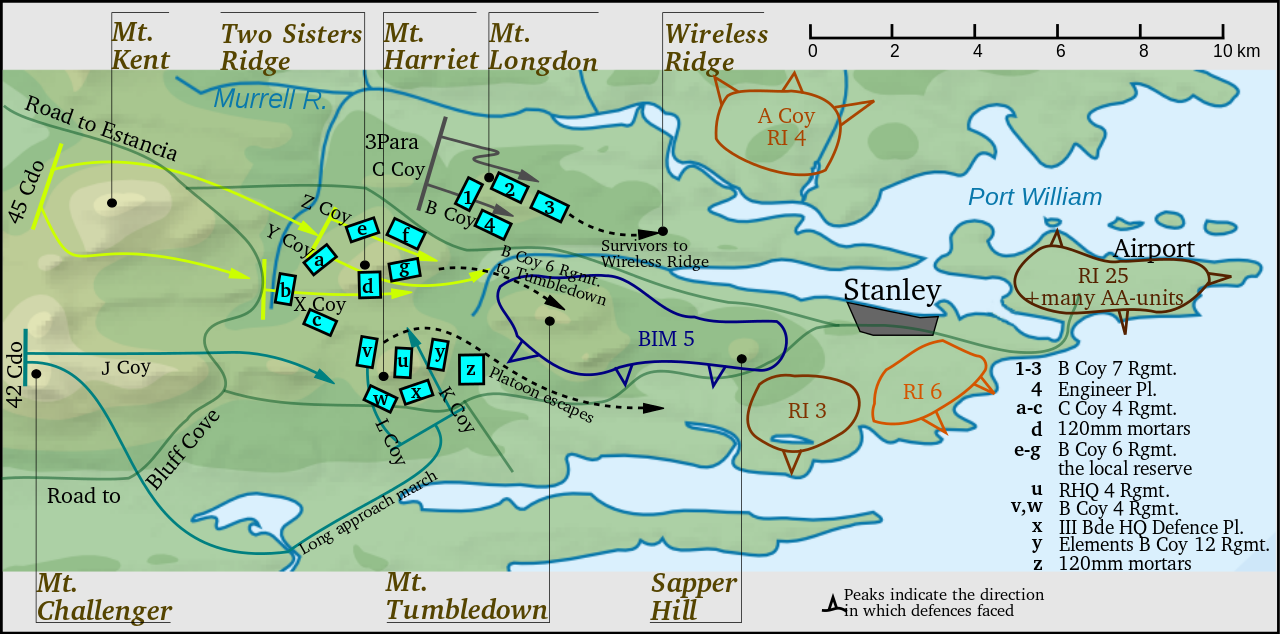
The first attack would be carried out by 3 Para, 45 Commando and 42 Commando, who would seize the Argentinian positions on Mount Longdon, Two Sisters and Mount Harriet respectively. All three were major hills overlooking Stanley, and each was held by about a battalion, so the attackers had maybe a 50% edge in numbers at each one. Mount Longdon, the northernmost of the hills, was also the most difficult to take. Despite the support of a battery of 105mm guns, and Avenger, 3 Para's initial attack was pushed back. They tried again and drove the defenders out, but at a cost of 23 dead. Two Sisters, a twin-peaked hill southwest of Longdon, was nearly as brutal. The Marines of 45 Commando were two hours late setting off, and quickly ran into heavy resistance. They eventually pushed their way onto the hill thanks to sheer tenacity and heavy fire support, including the twin 4.5" guns of Glamorgan, as well as liberal use of Milan anti-tank missiles to eliminate Argentinian positions. The Marine suffered only 8 dead, and took over 50 prisoners. The last position, Mount Harriet, fell more readily, as 42 Commando swung to the southeast, getting within 100 yards of the enemy positions before they were detected. Over 3,000 round of artillery were fired at Mount Harriet, which is probably part of the reason the Marines suffered only a single man dead in the process of taking the hill and 300 prisoners.2
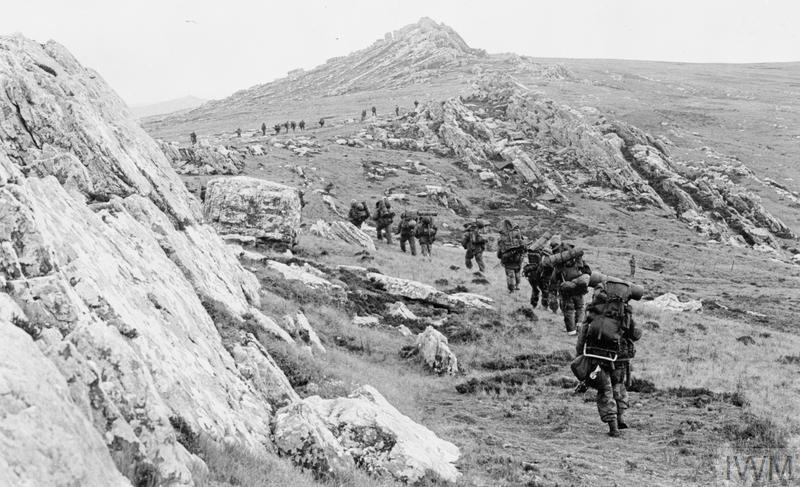
Marines on Mount Harriet
While all of this was going on, there was also action at sea. At 0215, Glamorgan and Yarmouth withdrew from the gunline, heading for the carrier group. Unfortunately, the destroyer accidentally crossed into range of the Exocet battery on the road outside Stanley, and her radar soon picked up something that looked like a shell from one of the artillery batteries that occasionally harassed the bombarding ships. It was only when Avenger, still on the gunline, saw the missile that the crew of Glamorgan knew what they were dealing with. In fact, this was the second missile the battery had tried to launch, but the first weapon had failed to fire. As the Exocet closed, they fired off a Seacat, which came surprisingly close to hitting. Unfortunately, it didn't, and the Exocet instead impacted the destroyer.
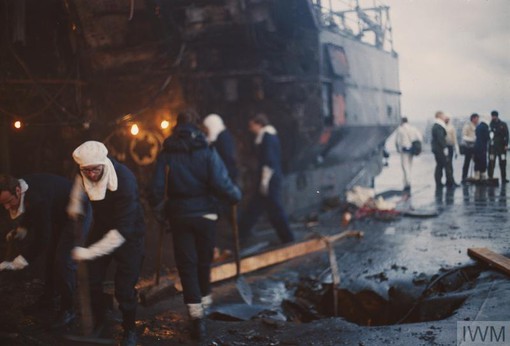
Damage control aboard Glamorgan
At the last moment, Glamorgan had turned away, and the missile, instead of hitting squarely, struck the edge of the flight deck and went sliding into the hangar before exploding. The destroyer's Wessex helicopter, fully fueled, vanished in a fireball, flames penetrated into the galley below and into the uptakes for the gas turbines, putting half of the ship's propulsion plant out of action. The Seacat launcher was another victim, and the resulting fire was visible to many of the men ashore. But Glamorgan's crew quickly rallied to fight the fire, despite 13 dead, and her steam plant3 was still intact. Her captain chose to return to the carriers instead, the first ship to survive an Exocet hit.4
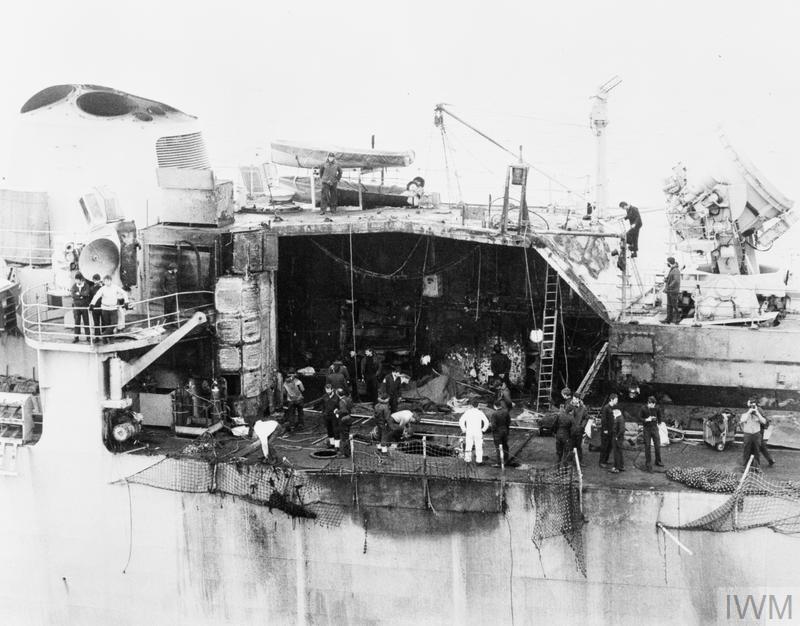
Damage to Glamorgan's hangar
With the dawn came the last Black Buck raid, this one armed with thousand-pound bombs and aimed not at the runway but at the aircraft and equipment nearby. A few hours later, the day's objectives were secured, with the Marines and Paras firmly entrenched despite artillery fire from the defenders. The plan had been for 5 Infantry Brigade to take the last set of hills guarding Stanley the next night, but Major General Jeremy Moore, commanding the land forces, decided to delay 24 hours to allow the forces ashore to reconnoiter the new positions and build up more supplies.
The war was clearly in its final stages by this point, and all the British had to do was secure the last remaining hills over Stanley, Mount Tumbledown and Wireless Ridge, to put the defenders in a completely untenable position. And do that they would, as we'll see next time.
1 For more information on ships and aircraft, as well as links to the whole series, see my Falklands Glossary. ⇑
2 My casualty numbers don't match Wikipedia's, as I've chosen to use those from my Falklands War Operations Manual. I suspect that the casualty numbers are heavily confounded by what counts as part of the battle vs fighting the next day, and I chose what looks to be a mid-range source. ⇑
3 The County class destroyers were the first major warships to use gas turbines, in what is known as a Combined Steam and Gas (COSAG) plant. ⇑
4 Some of this is because Glamorgan was an early-60s County instead of a much later Type 42. She was more sturdily built than either Sheffield or Atlantic Conveyor, which probably contributed greatly to her survival. ⇑

Comments
Were any negotiations happening by this point? Did the Argentinans still hold out any hope of being allowed to withdraw rather than surrender?
Not quite. Technically, the Argentine government never really agreed to anything other than to say "we de facto won't violate the cease-fire already agreed in Stanley", which we'll come to next time. The commander on the ground was under orders not to surrender, which he didn't feel like violating quite yet.
It makes me feel a bit old to realize that the Falkland War (conflict, disagreement, whatever) was almost halfway between World War 2 and today.
Which leads to the question: to what degree was the tech being used more like WW2, and what parts would be completely different today with a completely different military behaviour?
There's a definite divide in air and naval warfare between what I guess we could call the gun age and the missile age. Major factors include (obviously) missiles, computers, jet aircraft and nuclear submarines, all of which came on the scene between the early 50s and the early 60s. The Falklands definitely falls on the missile age side, which we are still in.
The obvious difference is that there were no air-dropped torpedoes (that role was replaced by Exocet, apparently) and nothing larger than a 5" gun fired. (The General Belgrano had some 6" guns, according to Wikipedia).
Also, I don't think WWII combatants would have bothered with level-bombing ships from fighter-bombers; at least not after ... 1942?
There’s a lot of detail differences between WWII and the Falklands, but a modern war is going to be largely shaped by the same factors as the latter conflict. The big differences will probably be stand-off weapons and greater use of PGMs.
Assuming you’re referring to what Argentina was doing, actually, they did more of that than you’d think. Level bombing is the term for attacks from high altitude, which didn’t work in WWII, and weren’t tried against ships in the Falklands, except maybe by the Canberras. It was contrasted not just to dive and torpedo bombing, but to things like skip-bombing and low-level attacks more generally. Those would have been quite familiar to WWII pilots.
One recurring theme throughout this whole conflict is the Argentines successfully hitting their targets, but the bombs failing to go off due to bad fuzing. Do you know if the Argentines had any idea why their air raids were so unsuccessful, and if so, did they try to do anything to ensure that their bombs would actually go off when they hit?
I suspect they had a pretty good idea what was going on, from the BBC if nothing else. As for fixing it, bomb fuzes aren't the sort of thing you mess around with casually, because screwing them up tends to really dampen morale. If they didn't have an appropriate fuze in stock when the British showed up, then there wasn't a whole lot they could do. There's some discussion of this in the comments on Part 13.
Nuclear attack subs. Without those, the British would have had to actually fight for sea control.
The WW2 equivalent would have been a few battlecruisers, I guess? Maybe could have threatened bombardment and made the actual invasion superfluous.
Belgrano was a Brooklyn-class CL, so yeah, she had 15 6" guns, but AFAIK, didn't get a chance to fire them in anger. That's a not-insubstantial fraction of why the RN sunk Belgrano, IIRC - a floating battery of 6" guns is not exactly something you want anywhere near your invasion forces.
The invasion force was still well north at that point. The fear was that they didn't really have any weapons that could deal with her if she got within gun range of the carriers.
As an aside about WW2 gear in the Falklands, ARA SANTA FE was a WW2 era submarine. The inestimable WW2 After WW2 blog has a [nice little write-up about her]"https://wwiiafterwwii.wordpress.com/2020/07/18/last-voyage-of-ara-santa-fe-1982/" in the most recent post.
That sounds like an unpleasant job, although I suppose submerged submarines weren't too vulnerable to WWII-era contact and magnetic mines?
Now that's very interesting. Really underscores how badly the government screwed up. Was the junta mostly run by the elite army/paratroop type officers who usually do the coups?
@echo,
We discussed in an earlier installment how screwed up the Argentinian timing was.
The British were also in the middle of a naval transition, to a fleet considerably less able to do a major power projection. If the invasion had happened a year or two later about half the British ships and planes would have not been available.
But, as @bean (I think) pointed out, the Argentinians had their own, internal, reasons that the attack happened when it did. A long term, logical, strategic plan would have probably concluded not to prod the sleeping Brits in the first place.
They were more vulnerable than you might think, but they also had special sonars for mine detection. It would definitely be a stressful job, but doable.
No, actually the number one advocate of the invasion was the head of the Navy. It was just driven by internal politics. The Junta was under a lot of stress as a result of the Dirty War, and couldn't afford to wait a year. Particularly as the British might figure it out and send SSNs to patrol.
@bean
Was the concern about the Belgrano closing on the carrier really justified? Even if you ignore the Harriers, it seems like the escorting forces were bristling with exocets, as hardy as the <Brooklyns might be I feel it wouldn't be able to stand against them for long. (Not arguing that it should have been allowed to get that close, certainly better to not find out)
I think it was. The basic problem is that Exocets are designed to kill frigates, not cruisers, which means that the Exocets the British had (20 if I did my math right) might not be able to mission-kill it quickly enough. It certainly wouldn't be pleasant to be aboard if the ship got hit, but if the missile hits the belt, then it's just going to bounce off and mess up the paint. There will be some damage topside, but nothing that's going to reliably put the Belgrano out of action. Everything that can do that is armored and protected. Not perfectly, but certainly not badly enough that it's reasonable to gamble on the 10 or so Exocet hits you'd expect from the missiles available.
Also, on the subject of fusing, I can't remember where I heard this, but one thing that hindered the Argentines was they didn't have the tech manuals that gave them the proper procedures for setting the fuses for delay, and couldn't get their hands on them once the war started due to US embargo on them.
One of my takeaways from the Falklands War is how much it's an illustration of how just having nice equipment isn't much good if you lack the doctrine or the support capabilities to use them. Tactically (at least for the Air and Navy side, can't speak for the ground-pounders), the Argentines weren't bad, but operationally and strategically, they were a mess, and had major, major logistical shortfalls that limited what they could do so much.